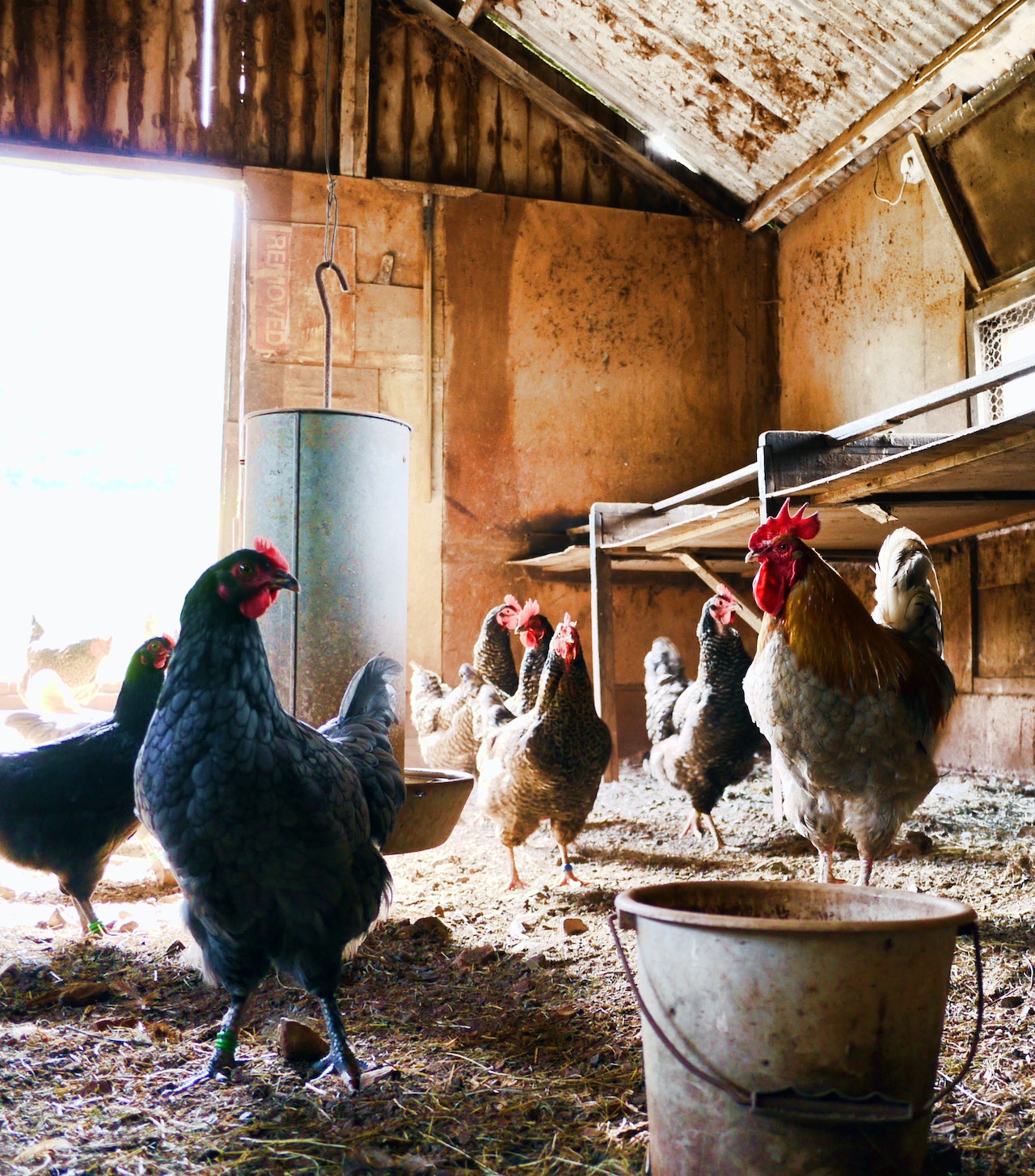By: Amelia Thyen
Image courtesy of Brett Jordan
Egg prices have been on the rise across the United States in recent months, in part due to the highly pathogenic avian influenza outbreak that has severely decreased the egg-laying poultry population.
Avian influenza is caused by the influenza A virus, and is constantly spreading among wild aquatic bird populations globally.1 Ducks are thought to be the reservoir host, meaning they harbor the virus without becoming ill, and are often the primary source of influenza A outbreaks among other avian species.1 There are many different subtypes of the avian influenza A virus; the most prominent currently circulating subtype is H5N1.2 Occasionally, the virus can be transmitted from the reservoir hosts to domestic poultry and other wild bird species, and wreak havoc on the population. Most avian influenza viruses are considered low pathogenic avian influenza, as they cause relatively mild or no symptoms of disease.1 However, occasionally some low pathogenic avian influenza viruses mutate and become more highly pathogenic, causing more severe disease, especially among domestic poultry populations.1 Once one bird within a flock is infected with highly pathogenic avian influenza, the virus can spread rapidly among the population through droppings, saliva or contaminated food/water, and has a very high mortality rate of about 90%-100%.1
The United States saw a similar outbreak of highly pathogenic avian influenza back in 2015, which at the time was the largest outbreak ever recorded.3 There were approximately 50 million domestic birds affected during the outbreak in 2015, which prompted the average price of a dozen eggs to double from the previous three-year average.4 However, the current outbreak has surpassed that record for the largest avian influenza outbreak to date. Since October of 2022, the United States Department of Agriculture has reported that nearly 58 million domestic birds have been infected.5 This has resulted in the culling of many commercial and backyard poultry flocks, in an effort to reduce spread among the avian population.6
Consumers have seen the impacts of this decrease in supply of egg-laying hens across the country in the form of rising egg prices in grocery stores. The average cost of a dozen eggs in the United States reached a peak of close to five dollars in December 2022, up 238% from the same time in the previous year.7
In addition to the heavy impact on farming communities and egg prices, the outbreak also poses threats to wild bird populations. Outbreaks among domestic poultry flocks can lead to virus mutations which can spill back over into wild bird populations. This is the case of the recent die-off of hundreds of wild snow geese in Colorado.8 A recent report also showed that as a result of spillover from wild birds, H5N1 mutations may be able to produce strains that are able to spread from mammal to mammal, which was observed last October at a mink farm in Spain.9 Migration patterns also contribute to disease spread among avian populations and have contributed to a widespread outbreak within the United States; since October 2022, all 50 US states have reported cases of H5N1 avian influenza in wild bird populations.10
Concern remains around the continued spread to international avian populations, and the potential for further impact on the supply of poultry products to consumers worldwide. Cases of highly pathogenic avian influenza have been reported largely in North and South America and Europe, including the United Kingdom and France.11 Migratory patterns from North America to South America since November may be contributing to international spread, and are expected to continue through March.12 Many South American countries, including Chile, Colombia, Ecuador, Peru, and Venezuela have all experienced avian influenza outbreaks among wild bird populations this year.13
Thankfully, public health officials are not overly concerned about the possibility of transmission to humans who are in close contact with infected birds; the CDC considers the risk to humans to be generally low.14 Although rare, human infection with avian influenza A is possible with subtypes H5, H7, and H9.15 The WHO reports that from 2003 to 2022 there were 868 reported cases and 457 reported deaths worldwide due to H5N1 infection, with only one human case of mild H5N1 infection reported in the United States during the current outbreak.16
For now, our egg prices will likely remain high until the poultry population is able to recover – which could take months.17 As with other influenza outbreaks, ongoing surveillance plays a large role in helping to understand the extent of an outbreak and inform mitigation solutions.18 The USDA Animal and Plant Health Inspection Service urges people who work in and around domestic poultry flocks to take extra precautions to limit spreading the virus.19 Precautions include that waterfowl hunters should minimize direct contact with wild birds, and wash hands, clothes, footwear, and vehicles after use. The USDA also recommends that anyone in direct contact with waterfowl should not be around domestic poultry populations for 72 hours after exposure, in order to limit potential viral spread.19 Commercial poultry producers also continue to follow strict biosecurity risk management guidelines such as limiting human interaction with the birds and maintaining clean facilities and personnel.20 In the future, we may see the widespread use of avian influenza vaccinations in domestic poultry populations21 – but until then it is important to maintain surveillance and mitigation practices, and hope that the spread decreases soon.
References
- https://www.cdc.gov/flu/avianflu/avian-in-birds.htm
- https://www.paho.org/en/documents/epidemiological-update-outbreaks-avian-influenza-and-public-health-implications-region-0
- https://www.aphis.usda.gov/animal_health/emergency_management/downloads/hpai/2015-hpai-final-report.pdf
- https://www.aphis.usda.gov/animal_health/emergency_management/downloads/hpai/2015-hpai-final-report.pdf
- https://www.aphis.usda.gov/aphis/ourfocus/animalhealth/animal-disease-information/avian/avian-influenza/hpai-2022/2022-hpai-commercial-backyard-flocks
- https://www.cdc.gov/flu/avianflu/spotlights/2022-2023/nearing-record-number-avian-influenza.htm#:~:text=Since%20early%202022%2C%20more%20than,to%20exposure%20to%20infected%20birds.
- https://www.ams.usda.gov/sites/default/files/media/Egg%20Markets%20Overview.pdf
- https://www.cnn.com/2023/01/17/us/hpai-colorado-wild-bird-mortality/index.html
- https://www.eurosurveillance.org/content/10.2807/1560-7917.ES.2023.28.3.2300001?utm_source=substack&utm_medium=email
- https://www.cdc.gov/flu/avianflu/data-map-wild-birds.html
- https://cdn.who.int/media/docs/default-source/influenza/human-animal-interface-risk-assessments/influenza-at-the-human-animal-interface-summary-and-assessment–from-12-november-to-5-january-2023.pdf?sfvrsn=8382d727_1&download=true
- https://www.wattagnet.com/blogs/23-poultry-around-the-world/post/46332-will-avian-influenza-reach-brazil
- https://www.paho.org/en/news/17-1-2023-paho-issues-alert-outbreaks-avian-influenza-birds-ten-countries-americas
- https://www.cdc.gov/flu/avianflu/prevention.htm
- https://www.cdc.gov/flu/avianflu/index.htm
- https://cdn.who.int/media/docs/default-source/influenza/human-animal-interface-risk-assessments/2022_nov_tableh5n1.pdf?sfvrsn=babfcad1_1&download=true
- https://unitedegg.com/egg-farms-make-progress-toward-recovery-and-repopulation-after-avian-influenza/
- https://www.usgs.gov/centers/nwhc/science/avian-influenza-surveillance#:~:text=HPAI%20Surveillance%20Update%202021%2D22,South%20Carolina)%20in%20December%202021.
- https://unitedegg.com/december-hpai-detections-on-decline-but-egg-industry-hit-hard/
- https://www.uspoultry.org/programs/poultry-health/biosecurity/
- https://www.vetmed.wisc.edu/researchers-work-to-develop-bird-flu-vaccine-to-contain-future-outbreaks/#:~:text=While%20avian%20flu%20vaccines%20are,the%20spread%20of%20the%20disease.


